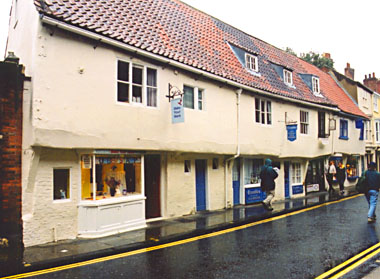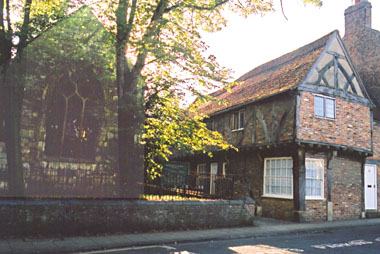
Our Lady's Row, Goodramgate, York
Photo © S. Alsford
Holme's chantry in the chapel of St. James was by no means the earliest in the church of Holy Trinity, Goodramgate. To endow a chantry dedicated to the Virgin Mary, a row of almshouses along with a priest's dwelling was built on the edge of the churchyard facing into Goodramgate, in 1316. An early example of row housing intended for tenants of little means, it originally comprised possibly eleven small cottage-like dwellings (later reduced to eight), each with one ground floor room and one room above, all under one continuous roof. Now 130' long and 16' deep, this row still survives in York, under the name "Our Lady's Row". The jettied buildings are the oldest examples of (relatively) unchanged domestic architecture in York and give a rare look at accommodations of the poorer members of urban society. Construction was of the half-timbered type, but the facades would have been plastered over, hiding the timbers, much as they are today.

All Saints (left, north aisle) and almshouse?
Photo © S. Alsford
A similar but later example of row housing is associated with the church of All Saints in North Street, York, which is first heard of in the third quarter of the twelfth century, but probably was a much older foundation. Beside it, separated only by an alleyway, stands a row of three timber-framed cottages; that fronting the street was slightly larger, having a short hall on the right-hand side of the ground floor room. their location suggests they may have been built on what was originally part of the churchyard, so that their rents could support a chantry in All Saints. They still belong to the church. The architectural style could make them contemporary with the known foundation of a chantry in All Saints ca.1410.